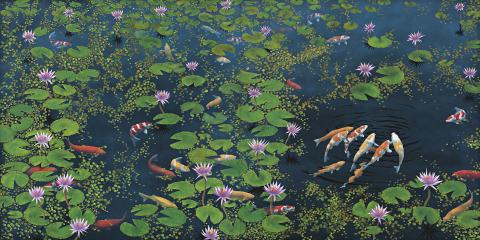RIDDLE OF THE KOI, 1994
LIN ONUS
synthetic polymer paint on canvas
diptych
200.0 x 400.0 cm (overall)
signed lower left: Lin Onus
Estate of the artist, Melbourne
Mossgreen, Melbourne
Private collection, Sydney
Yinya Wala, Mossgreen, touring exhibition London: 28 June – 3 July, Melbourne: 4 – 28 August,Brisbane: 9 – 24 September, Sydney: 8 – 30 October 2016 (illus. in exhibition catalogue)
‘I hope that history might see me as some sort of bridge between cultures...’1
Described as ‘a self-confessed cultural mechanic’2, Lin Onus remains acclaimed today for his dedication to reconciling cultures through his roles as artist, educator, activist and administrator. Of Yorta Yorta and Scottish descent, he began painting during the 1970s, coinciding with both the acknowledgment of Aboriginal art in Australia and the emergence of the political debate on issues of native title and equal opportunity. Straddling such dualistic perspectives – one Western and representational, the other Aboriginal and spiritual – Onus was thus able to explore fresh ideas from a diverse range of influences, subverting Western perceptions of indigenous art with subtlety and sophistication. Indeed, occupying what anthropologist Levi Strauss defines as that ‘in-between’ space between multiple worlds, Onus was afforded the rare opportunity ‘to glimpse through many slightly ajar doors’ – paradoxically belonging everywhere, and nowhere. As Margo Neale elaborates in the catalogue accompanying the artist’s retrospective at Queensland Art Gallery in 2000, ‘…his works are like the tales of a roving storyteller or mythmaker.’3
Of particular relevance to his celebrated ‘water and reflection’ paintings such as the vast and impressive diptych Riddle of the Koi, 1994 featured here, were Onus’s regular spiritual pilgrimages to Arnhem Land which, he later mused, gave him ‘back all the stuff that colonialism had taken away.’4 As Neale observes, ‘…now, in addition to his own ancestral site at Barmah forest he was permitted to access new sites of significance such as Arafura Swamp, or his adoptive community at the outstation Garmedi; to kinship systems in which he and his family were assigned skin names; to language that he used for many of the titles of his works; to ceremony and Dreaming stories.’5 Arguably most influential upon his stylistic evolution, however, was the relationship he fostered in Arnhem Land with the highly esteemed Aboriginal painter who became his adoptive father and mentor, Jack Wunuwun. Admiring the older artist’s bark painting techniques such as rarrk (cross-hatched designs), Onus subsequently embarked upon his highly acclaimed series of watery landscapes which, rich in reflections and ambiguities, substitute the traditional European panoramic view for one described by his mentor Wunuwun as ‘seeing below the surface.’
With his signature motifs of lilypads and fish alluding to the beauty and fragility of the land and our relationship to it, Riddle of the Koi was no doubt partly inspired by the artist’s experience of Japanese society gleaned from his residency in Yokohama in 1989. Particularly intrigued by the anomaly between the refined aesthetic of Japanese style that extended to carefully conceived and manicured gardens, and the highly industrialised nature of the large cities, indeed Onus reflects, ‘…these paradoxes were interesting, particularly in relation to their environment which was full of smog, chromium and glass and yet people were really into gardens… A garden isn’t complete without a pond and much less complete without fish.’6 Both mesmerisingly beautiful and multifaceted in its meaning, thus Riddle of the Koi illustrates well Onus’s desire to create an art that could be appreciated on numerous levels by everyone, not just an elite few. As Neale suggests, considering the deeper significance of such works, ‘…they are deceptively picturesque, for things are not always what they seem. Laden with crosscultural references, visual deceits, totemic relationships and a sense of displacement, they, amongst other things, challenge one’s viewing position: Are you looking up through water towards the sky, down into a waterhole from above, across the surface only or all three positions simultaneously?’7
1. Lin Onus, artist statement, 1990
2. Neale, M., Lin Onus, exhibition catalogue, Savill Galleries, Melbourne, 2003, p. 1
3. Neale, M., Urban Dingo: The Art of Lin Onus 1948–1996, Queensland Art Gallery, Brisbane, 2000, p. 18
4. Onus, L., cited ibid. p. 15
5. ibid. pp. 15–16
6. Onus, L., cited in ‘Australia’s great crossover indigenous artist comes to London for a one-man show at Messum’s’, 29 June 2016 at
7. Neale, op.cit., 2003, p. 1
VERONICA ANGELATOS
